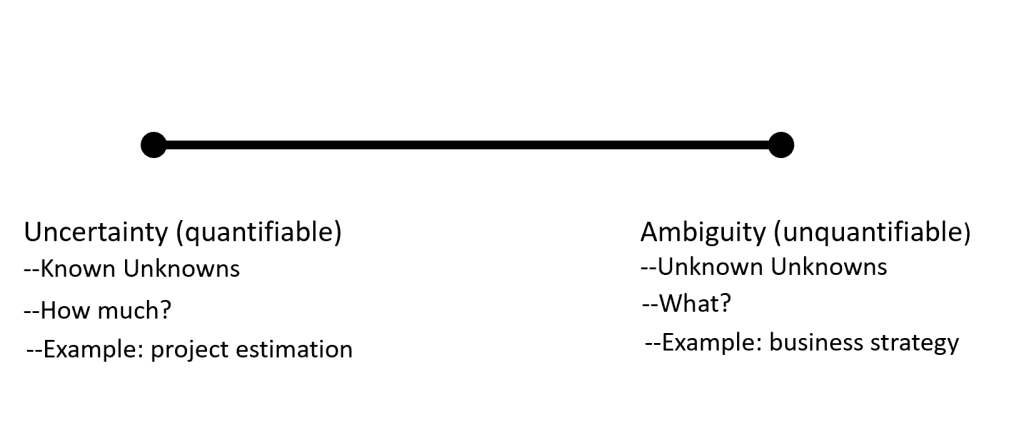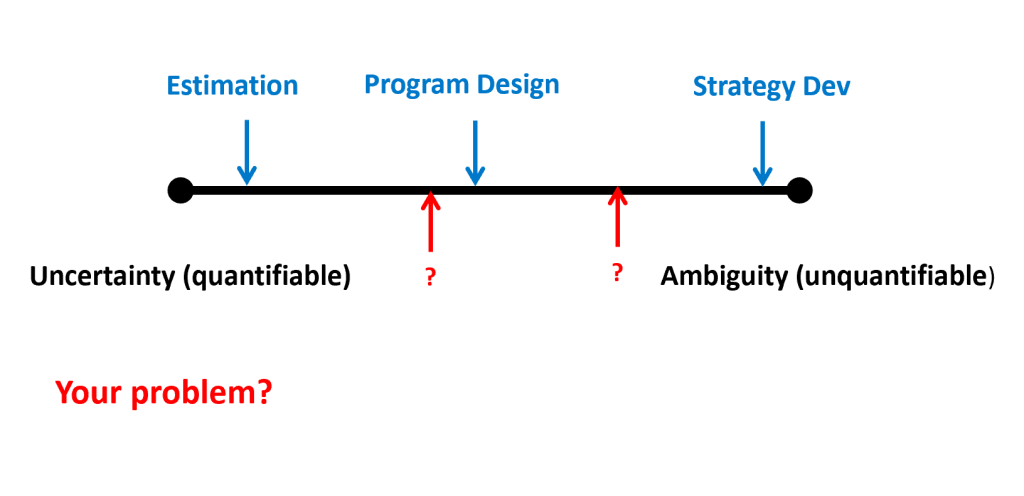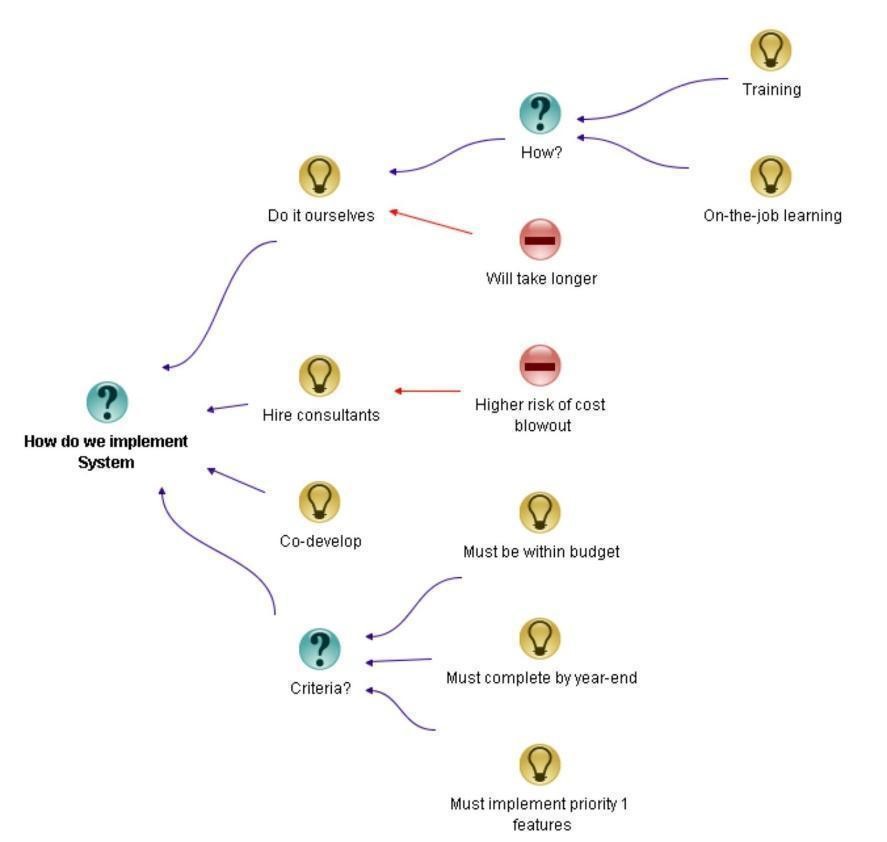From ambiguity to action – a paper preview
The powerful documentary The Social Dilemma highlights the polarizing effect of social media, and how it hinders our collective ability to address problems that impact communities, societies and even nations. Towards the end of the documentary, the technology ethicist, Tristan Harris, makes the following statement:
“If we don’t agree on what is true or that there’s such a thing as truth, we’re toast. This is the problem beneath all other problems because if we can’t agree on what is true, then we can’t navigate out of any of our problems.”
The central point the documentary makes is that the strategies social media platforms use to enhance engagement also tend to encourage the polarization of perspectives. A consequence is that people on two sides of a contentious issue become less likely to find common ground and build a shared understanding of a complex problem.
A similar dynamic plays out in organisations, albeit on a smaller and less consequential scale. For example, two departments – say, sales and marketing – may have completely different perspectives on why sales are falling. Since their perspectives are different, the mitigating actions they advocate may be completely different, even contradictory. In a classic paper, published half a century ago, Horst Rittel and Melvin Webber coined the term wicked problem to describe such ambiguous dilemmas.
In contrast, problems such as choosing the cheapest product from a range of options are unambiguous because the decision criteria are clear. Such problems are sometimes referred to as tame problems. As an aside, it should be noted that organisations often tend to treat wicked problems as tame, with less-than-optimal consequences down the line. For example, choosing the cheapest product might lead to larger long-term costs due to increased maintenance, repair and replacement costs.
The problem with wicked problems is that they cannot be solved using rational approaches to decision making. The reason is that rational approaches assume that a) the decision options can be unambiguously determined upfront, and b) that they can be objectively rated. This implicitly assumes that all those who are impacted by the decision will agree on the options and the rating criteria. Anyone who has been involved in making a contentious decision will know that these are poor assumptions. Consider, for example, management and employee perspectives on an organizational restructuring.
In a book published in 2016, Paul Culmsee and I argued that the difference between tame and wicked problems lies in the nature of uncertainty associated with the two. In brief, tame problems are characterized by uncertainties that can be easily quantified (e.g., cost or time in projects) whereas wicked problems are characterized by uncertainties that are hard to quantify (e.g., the uncertainties associated with a business strategy). One can think of these as lying at the opposite ends of an ambiguity spectrum, as shown below:

It is important to note that most real-world problems have both quantifiable and unquantifiable uncertainties and the first thing that one needs to do when one is confronted with a decision making situation is to figure out, qualitatively, where the problem lies on the ambiguity spectrum:

The key insight is that problems that have quantifiable uncertainties can be tackled using rational decision making techniques whereas those with unquantifiable uncertainties cannot. Problems of the latter kind are wicked, and require a different approach – one that focuses on framing the problem collectively (i.e., involving all impacted stakeholders) prior to using rational decision making approaches to address it. This is the domain of sensemaking, which I like to think of as the art of extracting or framing a problem from a messy situation.
Sensemaking is something we all do instinctively when we encounter the unfamiliar – we try to make sense of the situation by framing it in familiar terms. However, in an unfamiliar situation, it is unlikely that a single perspective on a problem will be an appropriate one. What is needed in such situations is for people with different perspectives to debate their views openly and build a shared understanding of the problem that synthesizes the diverse viewpoints. This is sometimes called collective sensemaking.
Collective sensemaking is challenging because it involves exactly the kind of cooperation that Tristan Harris calls for in the quote at the start of this piece.
But when people hold conflicting views on a contentious topic, how can they ever hope to build common ground? It turns out there are ways to build common ground, and although they aren’t perfect (and require diplomacy and doggedness) they do work, at least in many situations if not always. A technique I use is dialogue mapping which I have described in several articles and a book co-written with Paul Culmsee.

Regardless of the technique used, the point I’m making is that when dealing with ambiguous problems one needs to use collective sensemaking to frame the problem before using rational decision making methods to solve it. When dealing with an ambiguous problem, the viability of a decision hinges on the ability of the decision maker to: a) help stakeholders distinguish facts from opinions, b) take necessary sensemaking actions to find common ground between holders of conflicting opinions, and c) build a base of shared understanding from which a commonly agreed set of “facts” emerge. These “facts” will not be absolute truths but contingent ones. This is often true even of so-called facts used in rational decision making: a cost quotation does not point to a true cost, rather it is an estimate that depends critically on the assumptions made in its calculation. Such decisions, therefore, cannot be framed based on facts alone but ought to be co-constructed with those affected by the decision. This approach is the basis of a course on decision making under uncertainty that I designed and have been teaching across two faculties at the University of Technology Sydney for the last five years.
In a paper, soon to be published in Management Decision, a leading journal on decision making in organisations, Natalia Nikolova and I describe the principles and pedagogy behind the course in detail. We also highlight the complementary nature of collective sensemaking and rational decision making, showing how the former helps in extracting (or framing) a problem from a situation while the latter solves the framed problem. We also make the point that decision makers in organisations tend to jump into “solutioning” without spending adequate time framing the problem appropriately.
Finally, it is worth pointing out that the hard sciences have long recognized complementarity to be an important feature of physical theories such as quantum mechanics. Indeed, the physicist Niels Bohr was so taken by this notion that he inscribed the following on his coat of arms: contraria sunt complementa (opposites are complementary). The integration of apparently incompatible elements into a single theory or model can lead to a more complete view of the world and hence, how to act in it. Summarizing the utility of our approach in a phrase: it can help decision makers learn how to move from ambiguity to action.
For copyright reasons, I cannot post the paper publicly. However, I’d be happy to share it with anyone interested in reading / commenting on it – just let me know via a comment below.
Note added on 13 May 2022:
The permalink to the published online version is: https://www.emerald.com/insight/content/doi/10.1108/MD-06-2021-0804/full/html


I’d like to take you up on your offer for a copy of the article you coauthored and are about to publish.
Thanks
LikeLiked by 1 person
Marc
May 3, 2022 at 1:04 pm
Thanks for your interest Marc. Please send me your email address via the contact info on https://profiles.uts.edu.au/Kailash.Awati
LikeLike
K
May 3, 2022 at 6:38 pm
Yes I would be interested in your paper; _email redacted_
LikeLiked by 1 person
rumlia
May 3, 2022 at 2:07 pm
Thanks for your interest. I’ve emailed you a copy.
LikeLike
K
May 3, 2022 at 6:28 pm
Kailash, thanks for another good post on the importance of collective sensemaking!
There is one sentence that I don’t believe, namely: “It is worth noting that the approach we propose in the paper is consistent with research on hemispherical differences in the brain…” I am doubtful that the difference between wicked/messy/soft problem structuring and tame/technical/hard problem solving really has anything to do with hemispherical differences in the brain. It would be fine to say that one duality is very vaguely analogous to the other, as long as we recognize the major disanalogies as well, such as the complexity of the brain, the anatomy of which is nothing like the wicked/tame distinction below the very general level of two hemispheres. Your words “is consistent with research” does not make clear that the “consistency” is only a vague analogy or metaphor. As Kenan Malik said in his blog exchange with Iain McGilchrist: “Insofar as the thesis is metaphoric, I do not have a quarrel with it as such. But insofar as it attempts to provide a literal account, there are major conceptual problems…” Personally I would incline to emphasize the disanalogies and omit that sentence about the brain, though you may have some reason that I am overlooking for including it.
LikeLiked by 1 person
Nathan
May 4, 2022 at 1:39 am
Thanks for your feedback Nathan, appreciated as always. I agree: that statement is stronger than the evidence suggests; I’ve removed it.
LikeLike
K
May 4, 2022 at 5:08 am
would love a copy of the paper
surely there are proxy measures for even those uncertainties which are typically viewed as unquantifiable – using share price as a proxy measure for the impact of uncertainty on reputation, would make that uncertainty quantifiable
LikeLiked by 1 person
qveeden
May 4, 2022 at 3:57 am
Thanks, I’d be happy to send you a copy. Please send me your email address (mine is in the profile noted in one of my responses above). I agree there are proxy measures, the problem is to get people to agree on them. That’s where collective sensemaking can help.
LikeLiked by 1 person
K
May 4, 2022 at 5:10 am
I would very much like to read a copy please
LikeLiked by 2 people
Peter Schmidt
May 4, 2022 at 5:13 am
Thanks for your interest Peter. I’ve just emailed you a copy.
LikeLiked by 1 person
K
May 4, 2022 at 6:56 am
I would like a copy
LikeLiked by 1 person
kdiangel
May 5, 2022 at 5:25 am
Thanks for your interest! I’ve just emailed you a copy.
LikeLiked by 1 person
K
May 5, 2022 at 8:07 pm
I am also interested in the copy of your paper. I have emailed you.
I am in the process of reading your book. I am drawn towards your collective sense making approach, it articulates the frustration I have had with requirements in software development. Your approach takes User story creation couple of layers deep.
I have question – Do Cynefin’s complex domain & unstructured/wicked problems ( rittel and webber) point to same phenomena?
what is the similarities and differences between these approach?
Quantifiable uncertainties seems to lies in complicated domain of Cynefin.
LikeLiked by 1 person
ajit2022
August 4, 2022 at 12:44 pm
Hi Ajit,
Many thanks for reading and for taking the time to comment. I’ll send you a copy of the paper shortly.
Thanks, too, for the interest in the books that Paul and I wrote. Indeed, it was a frustration, similar to yours, that was the impetus for us to write them.
To answer your question in brief: yes, Snowden’s complex domain and Rittel’s wicked problem tend to be consequences of social complexity. You’re also right that quantifiable / understandable uncertainties are in the complicated domain – i.e., they can be handled by appropriate customisations of “best practice” frameworks.
Regards,
Kailash.
LikeLiked by 1 person
K
August 5, 2022 at 8:00 am